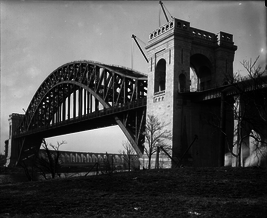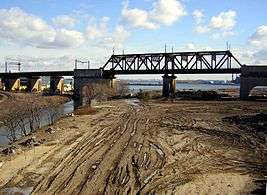Hell Gate Bridge
| Hell Gate Bridge | |
|---|---|
|
Hell Gate Bridge in 2008, with the Triborough Bridge and the Upper East Side skyline in the background | |
| Coordinates | 40°46′57″N 73°55′18″W / 40.7824°N 73.9217°WCoordinates: 40°46′57″N 73°55′18″W / 40.7824°N 73.9217°W |
| Carries | Amtrak Northeast Corridor; CSX/CP (D & H) freight |
| Crosses | Hell Gate of the East River |
| Locale | Queens and the Bronx in New York City via Randall's and Wards Islands |
| Owner | Amtrak |
| Maintained by | Amtrak |
| Characteristics | |
| Design | Through arch bridge |
| Material | nickel-magnenese steel |
| Total length | 17,000 feet (3.2 mi; 5.2 km) |
| Width | 100 feet (30.5 m) |
| Longest span | 978 feet (298 m) |
| Clearance below | 135 feet (41.1 m) |
| Rail characteristics | |
| No. of tracks |
3, 2 for Amtrak Northeast Corridor 1 for CSX/CP (D & H) |
| Track gauge | 4 ft 8 1⁄2 in (1,435 mm) standard gauge |
| Structure gauge | AAR |
| Electrified | 25 kV AC catenary |
| History | |
| Architect | Henry Hornbostel |
| Designer | Gustav Lindenthal |
| Engineering design by | Harold W. Hudson |
| Constructed by | American Bridge Inc. |
| Fabrication by | American Bridge Company |
| Construction begin | 1912 |
| Construction end | 1916 |
| Opened | March 9, 1917[1] |
 Hell Gate Bridge | |
The Hell Gate Bridge, originally the New York Connecting Railroad Bridge[2] or The East River Arch Bridge,[3] is a 1,017-foot (310 m)[4] steel through arch railroad bridge in New York City. The bridge crosses the Hell Gate, a strait of the East River, between Astoria in Queens and Randalls and Wards Islands in Manhattan.
The bridge is the largest of three bridges that form the Hell Gate complex. An inverted bowstring truss bridge with four 300-foot (91.4 m) spans crosses the Little Hell Gate (now filled in); and a 350-foot (106.7 m) fixed truss bridge crosses the Bronx Kill (now narrowed by fill). Together with approaches, the bridges are more than 17,000 feet (3.2 mi; 5.2 km) long.[5]
This bridge was the inspiration for the design of Sydney Harbour Bridge in Australia, which is about 60% larger.[6]
History



The bridge was conceived in the early 1900s to link New York and the Pennsylvania Railroad (PRR) with New England and the New Haven Railroad (NH).[7]
Construction was overseen by Gustav Lindenthal, whose original design left a gap of 15 feet (4.6 m) between the steel arch and the masonry towers. Fearing that the public assumed that the towers were structurally integral to the bridge, Lindenthal added aesthetic girders between the upper chord of the arch and the towers to make the structure appear more robust.[8] The original plans for the piers on the long approach ramps called for a steel lattice structure. The design was changed to smooth concrete to soothe concerns that asylum inmates on Wards and Randall's islands would climb the piers to escape.[8]
The engineering was so precise that when the last section of the main span was lifted into place, the final adjustment needed to join everything together was just 5⁄16 inch (7.9 mm). Construction of the Hell Gate Bridge began on March 1, 1912 and ended on September 30, 1916.[9] The bridge was dedicated and opened to rail traffic on March 9, 1917,[1] with Washington–Boston through trains first running on April 1.[10] It was the world's longest steel arch bridge until the Bayonne Bridge opened in 1931.[11]
During World War II, it was among the dozen or so targets of economic value of significant enough importance to attract the attention of Nazi German sabotage planners. The Nazis' Operation Pastorius landed German agents on American soil in 1942 in hopes of wrecking the bridge and other key targets. (Operation Pastorius failed due to detection of some landing activity by US shore patrols and subsequent defections among some of the German landing team's members to the Allied side.)[12]
In the 1990s, the bridge was repainted for the first time since it opened. It was painted a deep red called "Hell Gate Red". Due to a flaw in the paint, however, the red color began to fade before the work was completed, leading to the bridge's currently faded, splotchy appearance.[13]
The bridge would be the last New York City bridge to collapse if humans disappeared, taking at least a millennium to do so, according to the February 2005 issue of Discover magazine. Most other bridges would fall in about 300 years.[14]
Usage
Trackage
The bridge originally carried four tracks, two each for passenger and freight, but one freight track was abandoned in the mid-1970s. At one time, all tracks were electrified with the 11 kV, 25 Hz overhead catenary, the standard of NH and PRR. The passenger tracks have been electrified since 1917, and the freight tracks from 1927 to 1969, using Amtrak's 25 Hz traction power system.
Fares
Some passengers paid to use the bridge; some fares over the bridge were higher than the usual fares for the same mileage.[15] In September 1940, coach fares were two cents per mile, so Boston to New York was $4.60, the same to Grand Central Terminal or to Penn Station. But Boston to Washington, D.C. was $10.00 instead of the expected $9.10; for a few decades after 1920, 90 cents was added to all fares via Hell Gate except tickets to New York itself. In April 1962, New Haven to New York cost $3.43, New York to Philadelphia cost $3.91, and New Haven to Philadelphia was $8.24. (1962 fares do not include federal tax, then 10 percent.)
Current use
The bridge and structure are owned by Amtrak, and lies in the New York Terminal District, part of its Boston to Washington, D.C. electrified main line known as the Northeast Corridor. The bridge's two west most tracks are electrified with 12.5 kV 60 Hz overhead power and are used by Amtrak for Acela Express and regional service between New York and Boston. The Metro-North Railroad's Train to the Game services (Operated by New Jersey Transit, from main stations on the New Haven Line to Secaucus Junction) also use the bridge since September 2009 on every Sunday 1pm Giants or Jets NFL game at MetLife Stadium.[16]
The bridge is also part of the New York Connecting Railroad, a rail line that links New York City and Long Island to the North American mainland. The third track forms part of the CSX Fremont Secondary and carries CSX, Canadian Pacific and Providence & Worcester Railroad freight trains between Oak Point Yard in the Bronx and Long Island City, where it connects with the New York and Atlantic Railway. It is the only direct rail freight link between Long Island and the mainland.[lower-alpha 1]
In September 2009, Metro-North revived its planning efforts for its Penn Station Access project, which would use the Hell Gate Bridge to connect its New Haven Line to Penn Station.[17] Such a service would terminate at Penn Station on platforms freed up by the planned completion of the Long Island Rail Road's East Side Access project scheduled for completion in 2023. The environmental assessment and a draft Penn Station operations study were planned for completion in 2015.[17]
This photograph appears to have been taken from the top of the north tower of the Hell Gate Bridge itself. The view looks north toward the construction site of the bridge over Little Hell Gate (location:,[18] 2007 photo:[19]), which forms part of the northern approach to the Hell Gate Bridge proper.
See also
- List of bridges documented by the Historic American Engineering Record in New York
- Oak Point Link, connecting rail line in the Bronx
- Rail freight transportation in New York City and Long Island
References
Notes
- ↑ Long Island's railways only have two direct connections to the mainland. The other link to the mainland is via Penn Station, which goes through Manhattan first to get to the mainland. Freight trains are not permitted to use this route. There is also a rail freight barge service between Brooklyn and New Jersey run by the New York New Jersey Rail, LLC.
Citations
- 1 2 Thom, William G.; Sturm, Robert C. (2006). The New York Connecting Railroad. Long Island-Sunrise Chapter, National Railway Historical Society. p. 46. ISBN 9780988691605.
- ↑ Schneider, Daniel B. (March 19, 2000). "F.Y.I.". The New York Times. Retrieved 2011-01-23.
- ↑ Gruson, Lindsey (November 30, 1991). "Long Unlucky, Rail Bridge Hits $55 Million Repair Jackpot". The New York Times. Retrieved 2011-01-23.
- ↑ The arch is 1,087.5 feet (331.5 m) measured center to center of the concrete towers.
- ↑ Staff. "Growing a Bridge From Both Ends", p. 769, The Literary Digest, Volume 51, No. 14, October 2, 1915. Accessed July 7, 2016. "The whole length of the structure (arch and two approaches), from abutment on Long Island to abutment in the Bronx, is 17,000 feet, or considerably over three miles."
- ↑ "Sydney Harbour Bridge repainting" (PDF). NSW Roads and Traffic Authority. Retrieved 2011-10-03.
- ↑ Capo, Fran. Myths and Mysteries of New York: True Stories of the Unsolved and Unexplained, p. 71. Rowman & Littlefield, 2011. ISBN 9780762768974. Accessed July 7, 2016. "In the early 1900s, a plan was conceived for a bridge that would make Hell Gate even more accessible and wold also link the New Haven and Pennsylvania railways, creating direct passenger service from New York to Boston."
- 1 2 Anderson, Steve. "Hell Gate Bridge". NYCRoads. Retrieved 2010-04-13.
- ↑ Hell Gate Bridge at Structurae
- ↑ "HELL GATE SERVICE APRIL 1.; Through Trains from Washington to Boston Will Be Started Then.". The New York Times. 1917-03-14. Retrieved 2016-02-29.
- ↑ "Best Places to See NYC's Bridges", New York City Department of Parks and Recreation. Accessed April 18, 2016. "When it opened in 1931, the Bayonne Bridge surpassed the Hell Gate to become the longest steel arch bridge in the world and remained so for 45 years."
- ↑ MacDonnell, Frances (2 November 1995). Insidious Foes: The Axis Fifth Column and the American Home Front. Oxford University Press. p. 131. ISBN 0-1950-9268-6.
- ↑ Kilgannon, Corey (8 March 2012). "A Bad Impression Outlasts a Bridge's New Paint". New York Times. Retrieved 10 January 2015.
- ↑ Weisman, Alan (February 2005). "Earth Without People: What would happen to our planet if the mighty hand of humanity simply disappeared?". Discover. Retrieved 2006-11-06.
- ↑ Staff. "I.C.C. Orders Inquiry on 90c Extra Fare On Certain Trips Over Hell Gate Bridge", The New York Times, December 20, 1951. Accessed July 7, 2016.
- ↑ Silberstein, Judy (September 24, 2009). "Football Fans Take New Train to the Game". Larchmont Gazette. Retrieved 2011-07-03.
- 1 2 "Penn Station Access Study". Metropolitan Transportation Authority. September 2009. Retrieved 2008-04-12.
- ↑ "Wikimapia - Let's describe the whole world!". wikimapia.org.
- ↑ Amtrak Railway Bridge on Randall's Island NYC (Little Hell Gate) | Flickr – Condivisione di foto!. Flickr.com (2007-09-01). Retrieved on 2013-08-02.
Further reading
- Cook, Richard J. (1987). The Beauty of Railroad Bridges in North America – Then and Now. San Marino, California (USA): Golden West Books. ISBN 0-87095-097-5.
- Hell Gate Bridge at Structurae
- Historic American Engineering Record (HAER) No. NY-88, "New York Connecting Railroad, Hell Gate Bridge, Spanning East River, Wards Island & Astoria, New York, New York County, NY", 5 photos, 1 photo caption page
External links
 Media related to Hell Gate Bridge at Wikimedia Commons
Media related to Hell Gate Bridge at Wikimedia Commons
